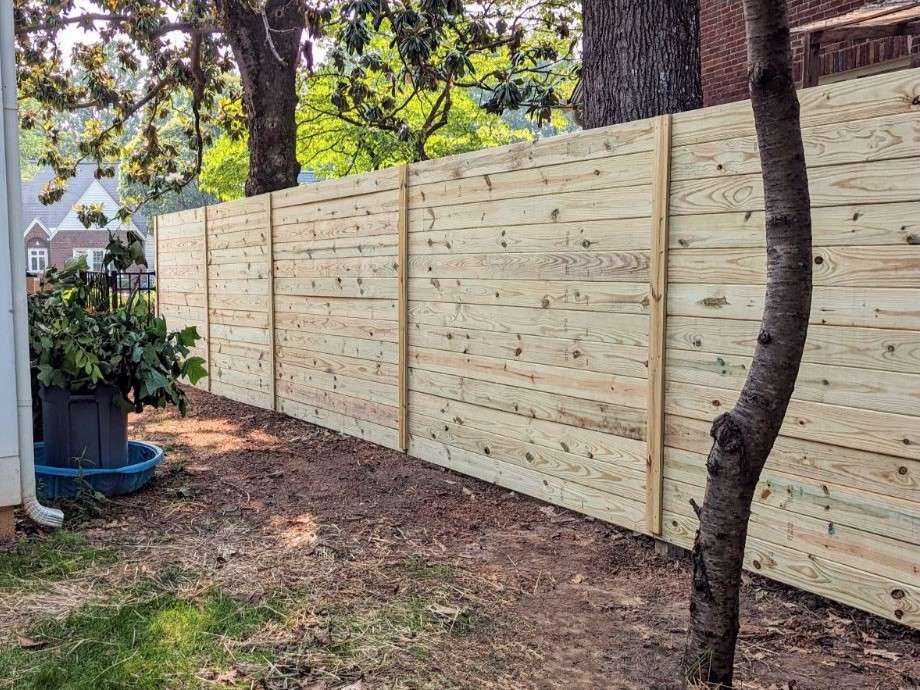Featured
Picking ecologically responsible secure fencing materials aids reduce your carbon footprint and sustains preservation efforts. Allow's discover some of the best eco-friendly secure fencing alternatives that advertise sustainability while also using resilience and design.
Advantages: Bamboo needs very little water, pesticides, and plant foods to expand. It is eco-friendly, decreasing waste at the end of its life process. It is additionally long lasting and resistant to rot, guaranteeing longevity with appropriate treatment. Considerations: Bamboo may not be suitable for locations with extreme winter seasons or extreme chilly, as it can become fragile and fracture in freezing temperature levels. 2. Recycled Products Fencing. Fencings made from recycled products, such as post-consumer plastics, recovered wood, or recycled metal, are ending up being progressively popular in eco-conscious designs. These materials minimize waste, conserve sources, and decrease the need for the extraction of resources, which is advantageous for the setting. By repurposing existing products, you add to decreasing the need for brand-new, energy-intensive manufacturing procedures.
Benefits: Utilizing recycled materials helps draw away waste from landfills, decreases ecological effect, and can decrease your carbon impact. It is additionally an economical remedy in many cases. Factors to consider: The aesthetic of recycled material fences can differ, and some might not achieve the same all-natural appearance as typical wood fences. Nonetheless, numerous manufacturers currently provide designs that reproduce the look of timber or stone. 3. Compound Fence. Compound secure fencing is made from a combination of timber fibers and plastic, usually sourced from recycled material. This kind of fencing uses the appearance of timber with marginal upkeep, while likewise being environmentally pleasant. Composite products are immune and generally lasting to the elements, reducing the requirement for regular substitute or treatment with chemicals.
![]()
Advantages: Compound fences are sturdy, low-maintenance, and can be made from recycled content, helping decrease waste. They do not need unsafe chemicals for conservation, unlike treated timber. Factors to consider: While composite secure fencing is sturdy, it tends to be more expensive upfront compared to standard wood. Its long life and reduced upkeep may make it a more affordable choice over time. 4. Cedar and Redwood Secure Fencing. Cedar and redwood are prominent options for environmentally-conscious secure fencing, as both materials are naturally sturdy, immune to decay, and require marginal chemical treatments. These timbers can be sustainably collected from responsibly handled woodlands, guaranteeing their green standing. They additionally have a natural appeal that many house owners appreciate, with rich colors and appearances that boost aesthetic appeal.
Conveniences: Cedar and redwood fences are durable, naturally pest-resistant, and have a reduced environmental influence when gathered sustainably. They likewise have a timeless aesthetic and can mix seamlessly into all-natural landscapes. Considerations: While cedar and redwood are much more eco-friendly than other sorts of wood, they are still wood items and need proper upkeep to protect against degeneration. The cost may additionally be greater contrasted to various other materials. 5. Living Fencings (Hedges and Bushes) For those looking for a much more environment-friendly and natural choice, living fences, or hedgerows, are an exceptional choice. Popular selections for living fences consist of boxwood, bamboo, and privet.
Conveniences: Living fencings improve air top quality, add to biodiversity, and offer an all-natural look that mixes perfectly with the landscape. They additionally lower sound pollution and help control temperature levels in your backyard. Considerations: Living fences require routine maintenance, such as pruning and watering, and may not appropriate for each environment. They additionally require time to establish prior to they can give complete privacy. 6. Rock and Block Fencing (Recovered) Rock and block are unbelievably sturdy materials, and making use of recovered rock or brick can be a green means to build a fence. By reusing these products from old buildings or structures, you reduce the demand for new resources and minimize waste. Rock and block fences are strong, need little maintenance, and give a timeless appearance to any building.
![]()
Benefits: Recovered rock and brick fences are incredibly resilient, low-maintenance, and provide superb privacy and safety. They are likewise energy-efficient, as they aid regulate temperature level by acting as natural insulators. Considerations: Installment of rock and block fencings can be more labor-intensive and pricey than various other products. In addition, these fencings may not appropriate for all residential or commercial properties due to the weight and the requirement for appropriate installation. Conclusion. Environmentally friendly fence choices are extensively offered and can be customized to suit the visual and useful requirements of your building. Bamboo, recycled materials, composite fencing, and cedar or redwood all offer sustainable choices to conventional products. Living fences and recovered rock or brick provide additional eco-conscious options that likewise help enhance your outside space. By picking one of these lasting secure fencing materials, you're making a favorable influence on the setting while developing a lovely and practical outdoor area. Whether you're concentrated on reducing your carbon impact or sustaining biodiversity, there's a variety of green alternatives to take into consideration.
- Bamboo Fence. Bamboo is just one of one of the most environmentally friendly materials offered for fence. As one of the fastest-growing plants worldwide, bamboo is incredibly sustainable, able to expand back swiftly after being gathered. Unlike hardwood trees, which can take decades to develop, bamboo gets to complete development in just a couple of years, making it an optimal sustainable alternative. Bamboo fencings are solid, naturally resistant to insects, and provide a gorgeous, all-natural aesthetic.
Advantages: Bamboo needs very little water, pesticides, and plant foods to expand. It is eco-friendly, decreasing waste at the end of its life process. It is additionally long lasting and resistant to rot, guaranteeing longevity with appropriate treatment. Considerations: Bamboo may not be suitable for locations with extreme winter seasons or extreme chilly, as it can become fragile and fracture in freezing temperature levels. 2. Recycled Products Fencing. Fencings made from recycled products, such as post-consumer plastics, recovered wood, or recycled metal, are ending up being progressively popular in eco-conscious designs. These materials minimize waste, conserve sources, and decrease the need for the extraction of resources, which is advantageous for the setting. By repurposing existing products, you add to decreasing the need for brand-new, energy-intensive manufacturing procedures.
Benefits: Utilizing recycled materials helps draw away waste from landfills, decreases ecological effect, and can decrease your carbon impact. It is additionally an economical remedy in many cases. Factors to consider: The aesthetic of recycled material fences can differ, and some might not achieve the same all-natural appearance as typical wood fences. Nonetheless, numerous manufacturers currently provide designs that reproduce the look of timber or stone. 3. Compound Fence. Compound secure fencing is made from a combination of timber fibers and plastic, usually sourced from recycled material. This kind of fencing uses the appearance of timber with marginal upkeep, while likewise being environmentally pleasant. Composite products are immune and generally lasting to the elements, reducing the requirement for regular substitute or treatment with chemicals.

Advantages: Compound fences are sturdy, low-maintenance, and can be made from recycled content, helping decrease waste. They do not need unsafe chemicals for conservation, unlike treated timber. Factors to consider: While composite secure fencing is sturdy, it tends to be more expensive upfront compared to standard wood. Its long life and reduced upkeep may make it a more affordable choice over time. 4. Cedar and Redwood Secure Fencing. Cedar and redwood are prominent options for environmentally-conscious secure fencing, as both materials are naturally sturdy, immune to decay, and require marginal chemical treatments. These timbers can be sustainably collected from responsibly handled woodlands, guaranteeing their green standing. They additionally have a natural appeal that many house owners appreciate, with rich colors and appearances that boost aesthetic appeal.
Conveniences: Cedar and redwood fences are durable, naturally pest-resistant, and have a reduced environmental influence when gathered sustainably. They likewise have a timeless aesthetic and can mix seamlessly into all-natural landscapes. Considerations: While cedar and redwood are much more eco-friendly than other sorts of wood, they are still wood items and need proper upkeep to protect against degeneration. The cost may additionally be greater contrasted to various other materials. 5. Living Fencings (Hedges and Bushes) For those looking for a much more environment-friendly and natural choice, living fences, or hedgerows, are an exceptional choice. Popular selections for living fences consist of boxwood, bamboo, and privet.
Conveniences: Living fencings improve air top quality, add to biodiversity, and offer an all-natural look that mixes perfectly with the landscape. They additionally lower sound pollution and help control temperature levels in your backyard. Considerations: Living fences require routine maintenance, such as pruning and watering, and may not appropriate for each environment. They additionally require time to establish prior to they can give complete privacy. 6. Rock and Block Fencing (Recovered) Rock and block are unbelievably sturdy materials, and making use of recovered rock or brick can be a green means to build a fence. By reusing these products from old buildings or structures, you reduce the demand for new resources and minimize waste. Rock and block fences are strong, need little maintenance, and give a timeless appearance to any building.

Benefits: Recovered rock and brick fences are incredibly resilient, low-maintenance, and provide superb privacy and safety. They are likewise energy-efficient, as they aid regulate temperature level by acting as natural insulators. Considerations: Installment of rock and block fencings can be more labor-intensive and pricey than various other products. In addition, these fencings may not appropriate for all residential or commercial properties due to the weight and the requirement for appropriate installation. Conclusion. Environmentally friendly fence choices are extensively offered and can be customized to suit the visual and useful requirements of your building. Bamboo, recycled materials, composite fencing, and cedar or redwood all offer sustainable choices to conventional products. Living fences and recovered rock or brick provide additional eco-conscious options that likewise help enhance your outside space. By picking one of these lasting secure fencing materials, you're making a favorable influence on the setting while developing a lovely and practical outdoor area. Whether you're concentrated on reducing your carbon impact or sustaining biodiversity, there's a variety of green alternatives to take into consideration.
Latest Posts
Explore Brake Repair & More: Full Auto Care Solutions from Montclare Auto Repair
Published May 27, 25
1 min read
Discover Exclusive Auto Repair Offers in Chicago at Montclare Auto Repair
Published May 26, 25
1 min read
Learn About Leading Car Repair Care offered by Montclare Auto Repair – Quality Service Today
Published May 23, 25
1 min read
More
Latest Posts
Explore Brake Repair & More: Full Auto Care Solutions from Montclare Auto Repair
Published May 27, 25
1 min read
Discover Exclusive Auto Repair Offers in Chicago at Montclare Auto Repair
Published May 26, 25
1 min read
Learn About Leading Car Repair Care offered by Montclare Auto Repair – Quality Service Today
Published May 23, 25
1 min read